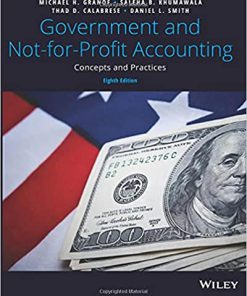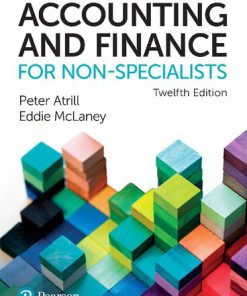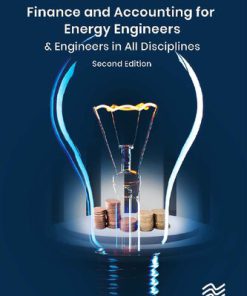Accounting and Finance for Lawyers in a Nutshell 6th Edition by Charles Meyer 1634608518 9781634608510
$50.00 Original price was: $50.00.$25.00Current price is: $25.00.
Accounting and Finance for Lawyers in a Nutshell 6th Edition by Charles Meyer – Ebook PDF Instant Download/Delivery: 1634608518, 9781634608510
Full download Accounting and Finance for Lawyers in a Nutshell 6th Edition after payment

Product details:
ISBN 10: 1634608518
ISBN 13: 9781634608510
Author: Charles Meyer
This product provides a well-rounded summary of the relevant accounting areas from basic financial statements to complex earnings-per-share ratios and corporate finance and valuation. Learn how to recognize revenue, expenses, assets, and liabilities. It reviews accounting principles for many different areas, including acquisitions, investments, long-term debt, leases, stocks, and partnerships. It also discusses recent developments such as adoption of new requirements to place most operating leases on the lessee’s balance sheet, a new principles based approach to accounting for revenue, refinements in the accounting for stock options, and revised rules for applying the lower of cost or market rule to inventory.
Accounting and Finance for Lawyers in a Nutshell 6th Table of contents:
Chapter 1 The Basic Financial Statements
A. The Balance Sheet
1. Assets
2. Liabilities
3. Owners’ Equity
4. The Balance Sheet Equation
5. Balance Sheet Format
B. The Income Statement
1. Revenues and Gains
2. Expenses and Losses
3. Format of the Income Statement
C. The Statement of Owners’ Equity
D. Statement of Cash Flows
E. Additional Information
1. Footnotes
2. Supplemental Disclosures
3. Management’s Discussion and Analysis
4 Audit Report
Chapter 2 The Accounting Process
A. Source Documents
B. Journal Entries
C. Ledgers and Posting
D. Adjusting Entries
1. Accrued Revenues and Expenses
a. Accrued Revenues
b. Accrued Expenses
c. Accounting for Actual Receipt of Payment
d. Reversing Entries
2. Deferred Revenues and Expenses
a. Deferred Revenues
b. Prepaid Expenses
3. Depreciation Expense
4. Recognizing Cost of Goods Sold
E. Revenue and Expense Accounts
F. Closing the Books
G. Preparation of Financial Statements
Chapter 3 Generally Accepted Accounting Principles
A. Sources of GAAP
1. Pre-Codification Official Pronouncements of the FASB and Its Predecessors
a. FASB Statements and Interpretations
b. APB Opinions
c. Accounting Research Bulletins
d. Enforcement of Official Standards
2. Other Sources of GAAP
B. Governmental Regulation of Accounting
1. SEC
2. Regulatory Agencies
C. Income Tax Accounting
D. Some Fundamental Accounting Concepts
1. Historical Cost
2. Measuring Fair Value
3. The Going Concern Assumption
4. Yearly Reporting
5. Revenue Recognition and Matching
6. Conservatism
7. Materiality and Cost-Benefit Analysis
Chapter 4 Recognition of Revenues and Expenses
A. Revenue Recognition
1. Sale of Goods or Services
2. Revenue from Services
a. Specific Performance Method
b. Proportional Performance Method
c. Completed Performance Method
3. New Rules on Revenue Recognition
4. Long-Term Contracts
5. Revenue Recognized with the Passage of Time
6. Revenue Recognized Based on Receipt of Cash
7. Completion of Production
8. Changes in Market Value
9. Asset Writedowns
B. Matching
1. Direct Matching
2. Immediate Write-Off
3. Systematic and Rational Allocation
Chapter 5 Current Assets and Liabilities
A. Cash
1. Cash Equivalents
2. Restricted Cash
3. Petty Cash
4. Internal Controls
B. Marketable Securities
C. Receivables
1. Trade Receivables
2. Other Receivables
3. Reporting Receivables
4. Bad Debts
a. Percentage of Sales Method
b. Aged Receivables Analysis
5. Financing and Sales of Receivables
6. Notes Receivable
7. Imputing Interest
8. Receivables from Related Parties
D. Prepayments
E. Accounts Payable
1. Reporting Accounts Payable
2. Imputing Interest
F. Short-Term Borrowings
1. Interest on Notes Payable
2. Currently Maturing Amounts of Long-Term Debt
G. Accrued Liabilities
H. Deferred Revenues and Deposits
I. Estimated Liabilities
J. Contingent Liabilities
Chapter 6 Accounting for Inventories
A. Determining Physical Quantities on Hand
1. Periodic Inventory System
2. The Perpetual Inventory System
B. Determining Inventory Values
1. Specific Identification
2. Cost Flow Assumptions
a. First In, First Out Method
b. Last In, First Out Method
c. Average Cost
d. Application to Perpetual Inventory Systems
e. Retail Inventory Methods
C. Applying Lower of Cost or Market
1. Determining Market
2. Effect on Inventory and Cost of Goods Sold
D. Manufacturing Companies
Chapter 7 Property, Plant, and Equipment and Depreciation
A. Accounting at Acquisition
1. General Rule
2. Exchanges for Other Property
3. Acquisitions of Multiple Assets
4. Self-Constructed Assets
B. Accounting for Depreciation
1. Useful Life
2. Salvage Value
3. Method of Depreciation
a. Straight-Line Method
b. Sum-of-the-Years’-Digits Method
c. Declining Balance Method
d. Units of Production Method
e. Depletion of Natural Resources
f. Other Methods
C. Repairs and Improvements
D. Disposal of Fixed Assets
E. Impairment of Fixed Assets
Chapter 8 Intangible Assets
A. Identifiable Intangible Assets
1. Types of Identifiable Intangible Assets
a. Patents
b. Copyright
c. Trademarks, Service Marks, and Trade Names
d. Franchises
e. Deferred Charges
2. Accounting for the Purchase of Identifiable Intangible Assets
3. Initial Accounting for Internally Created Identifiable Intangible Assets
a. Research and Development
b. Computer Software Costs
4. Accounting for Identifiable Intangible Assets After Acquisition
B. Goodwill
Chapter 9 Accounting for Investments
A. Investments in Bonds
1. Acquisition of Bonds at Face Value
2. Acquisition of Bonds at a Discount or Premium
a. Straight-Line Amortization of Bond Discount or Premium
b. Effective Interest Method of Amortizing Bond Discount and Premium
3. Changes in Value After Acquisition
4. Impairments of Loans
B. Accounting for Stock Investments
1. The Cost Method
a. Dividend Income
b. Changes in Value After Acquisition
c. Stock Splits and Stock Dividends
2. The Equity Method
3. Consolidated Financial Statements
4. Consolidation of Variable Interest Entities
C. Derivatives and Other Financial Instruments
1. Definition of Derivatives
2. Accounting for Derivatives
a. Fair Value Hedges
b. Cash Flow Hedges
c. Foreign Currency Hedges
D. Other Investments
1. Land
2. Cash Value of Life Insurance
3. Sinking Funds and Other Permanent Funds
Chapter 10 Accounting for Long-Term Debt
A. Forms of Long-Term Debt
B. Accounting for Long-Term Debt Issued at Par Value
1. Issuance on an Interest Payment Date
2. Issuance of Bonds Between Interest Payment Dates
C. Accounting for the Issuance of Bonds at Other than Par Value
1. Bonds Issued at a Discount
2. Bonds Issued at a Premium
D. Bond Issuance Costs
E. Retirement of Bonds Prior to Maturity
1. Actual Retirements
2. In-Substance Defeasance
F. Restructuring of Long-Term Debt
1. Restructuring with No Gain or Loss
2. Restructuring with Recognition of Gain
G. Convertible Debt
1. Conversion—Book Value Method
2. Conversion—Market Value Method
3. Induced Conversions
4. Debt Issued with Stock Warrants
H. Stock Treated as Debt
1. Mandatorily Redeemable Stock
2. Obligations to Repurchase Shares
3. Certain Obligations to Issue Shares in the Future
Chapter 11 Accounting for Leases
A. Introduction
B. Characterizing and Accounting for Leases
1. Accounting by the Lessee
2. Accounting by the Lessor
3. Changes in the Terms of a Lease Originally Treated as a Capital Lease
C. Special Rules
1. Leveraged Leases
2. Leases Involving Real Estate
3. Sale/Leasebacks
D. Disclosures Regarding Leases
Chapter 12 Accounting for Other Long-Term Liabilities
A. Accounting for Income Taxes
1. Temporary Differences
a. Types of Temporary Differences
b. Deferred Tax Liabilities
c. Deferred Tax Assets
d. Analysis of Deferred Taxes
e. Multiple Period Effects
2. Net Operating Losses
3. Valuation Allowances on Deferred Tax Assets
4. Reporting Deferred Tax Liabilities and Assets in the Balance Sheet
5. Intraperiod Tax Allocation
6. Permanent Tax Differences
B. Accounting for Retirement Plans
1. Defined Contribution Plans
2. Defined Benefit Plans
a. Components of Pension Expense
b. Pension Assets and Liabilities
c. Under- or Over-Funded Status
d. Disclosures
C. Accounting for Other Post-Retirement Benefits
Chapter 13 Accounting for Stock and Stockholders’ Equity
A. Contributions to Capital
1. Contributed Capital Accounts
2. Issuing Stock for Cash
3. Issuing Stock for Noncash Property
4. Stock Subscriptions
5. Stock Issuance Costs
6. Disclosures About Capital Structure
B. Accounting for Retained Earnings
C. Accounting for Dividends and Other Distributions
1. Key Dates Related to Dividends
2. Cash Dividends
3. Property Dividends
4. Stock Dividends
5. Distributions of Stock Rights
6. Stock Splits
D. Other Adjustments to Retained Earnings
1. Prior Period Adjustments
2. Appropriations
E. Accounting for Treasury Stock
1. The Cost Method
2. The Par Value Method
F. Convertible Stock
G. Stock Options and Stock Appreciation Rights
1. Stock Options
2. Stock Appreciation Rights
3. Disclosures
H. Other Comprehensive Income
Chapter 14 Partnership Accounting
A. Capital Accounts
B. Defining a Partner’s Interest in Profits and Losses
1. Allocating Individual Items of Income or Loss
2. Recognizing Different Forms of Partner Contributions
a. Allocation for Services
b. Return on Capital
c. Residual Income and Loss Sharing Ratios
C. Admission of New Partners
1. Transfer of Partnership Interests
a. No Adjustments to Partnership Net Assets
b. Adjusting Partnership Net Assets
2. Contribution to the Partnership
a. No Adjustments to Partnership Capital Accounts
b. The Goodwill Method
c. The Bonus Method
D. Retirement of Partners
1. Goodwill Method
2. Bonus Method
Chapter 15 Accounting for Business Combinations
A. Recording the Acquisition
B. Effects of the Acquisition Method on the Income Statement
C. Accounting for Acquisition Costs
D. Recording Adjustments in Stock Acquisitions
Chapter 16 Earnings per Share and Financial Ratios
A. Earnings per Share
1. Basic EPS
2. Diluted EPS
a. Effect of Stock Options
b. Effect of Convertible Securities
B. Financial Ratios
1. Measures of Liquidity
a. Current Ratio
b. Quick Ratio
2. Measures of Leverage
a. Debt-Equity Ratio
b. Debt to Asset Ratio
c. Times Interest Earned
d. Times Fixed Charges Earned
3. Activity Ratios
a. Asset Turnover
b. Receivables Turnover
c. Inventory Turnover
4. Measures of Profitability
a. Profit Margin
b. Return on Assets
c. Return on Equity
d. Earnings per Share
e. Price/Earnings Ratio
f. Payout Ratio
g. Dividend Yield
Chapter 17 Special Reporting Issues
A. Separately Reported Components of Income
1. Items That Are Unusual in Nature or Occur Infreqeuntly
2. Discontinued Operations
3. Income Statement Reporting
4. Other Comprehensive Income
5. Effects of a Change in Accounting Principle
B. Segment Reporting
1. Reporting on Operating Segments
2. Reporting on Foreign Operations and Export Sales
3. Information About Major Customers
4. Products and Services
C. Interim Financial Statements
Chapter 18 Corporate Finance— Valuation
A. Valuation of Securities
1. Valuation of Bonds
a. Mechanics of Bond Value Calculations
b. Determining Market Interest Rates
c. Bonds with Additional Features
2. Valuation of Preferred Stock
a. Nonredeemable Preferred Stock
b. Redeemable Preferred Stock
c. Rate of Return for Preferred Stock
d. Preferred Stock with Additional Features
3. Valuation of Common Stock
a. Constant Dividends
b. Dividends Growing at a Constant Rate
c. Present Value Analysis
d. Price/Earnings Multiples
e. Determining the Required Rate of Return
B. Cost of Capital
1. Determining a Company’s Cost of Capital
2. Use of Cost of Capital in Capital Budgeting
C. Valuation of a Business
1. Discounted Cash Flow Analysis
a. Estimate the Cash Flows for a Projection Period
b. Terminal Cash Flow
c. Determination of Discount Rate
d. Computation of the Value of the Firm
e. Example
2. Multiples Analysis
3. Asset Values
Chapter 19 International Accounting Issues
A. Accounting by U.S. Businesses Operating in Foreign Countries
1. Foreign Currency Transactions
2. Translating Foreign Currency Financial Statements
B. Accounting Rules in Other Countries
Appendix Time Value of Money
1. Future Value of $1
2. Present Value of $1
3. Future Value of an Annuity of $1
4. Present Value of an Annuity of $1
5. Irregular Cash Flows
People also search for Accounting and Finance for Lawyers in a Nutshell 6th:
8 principles of finance
7 accounting principles
6 accounting
6 accounting principles
Tags:
Charles Meyer,Accounting,Finance,Lawyers
You may also like…
Business & Economics - Accounting
Government and Not for profit Accounting 8th Edition Michael H. Granof
Business & Economics - Personal Finance
Uncategorized
Business & Economics - Accounting
Business Accounting and Finance 5th Edition Catherine Gowthorpe
Jurisprudence & Law - Criminal Law & Procedure
White Collar Crime in a Nutshell 6th Edition Ellen S. Podgot
Business & Economics - Accounting
Uncategorized
Business & Economics - Accounting
Accounting and Financial Management for Residential Construction 6th Edition Emma Shinn











